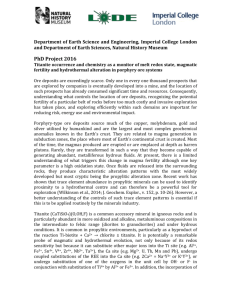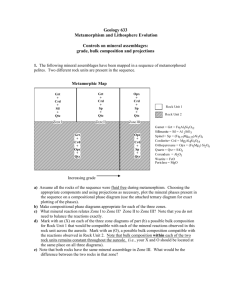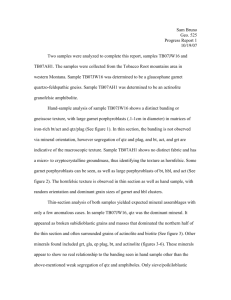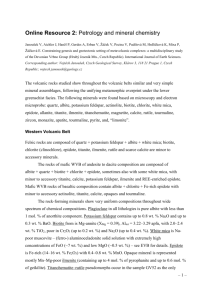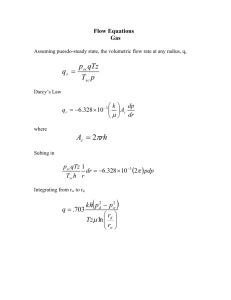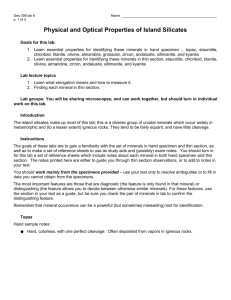Here
advertisement
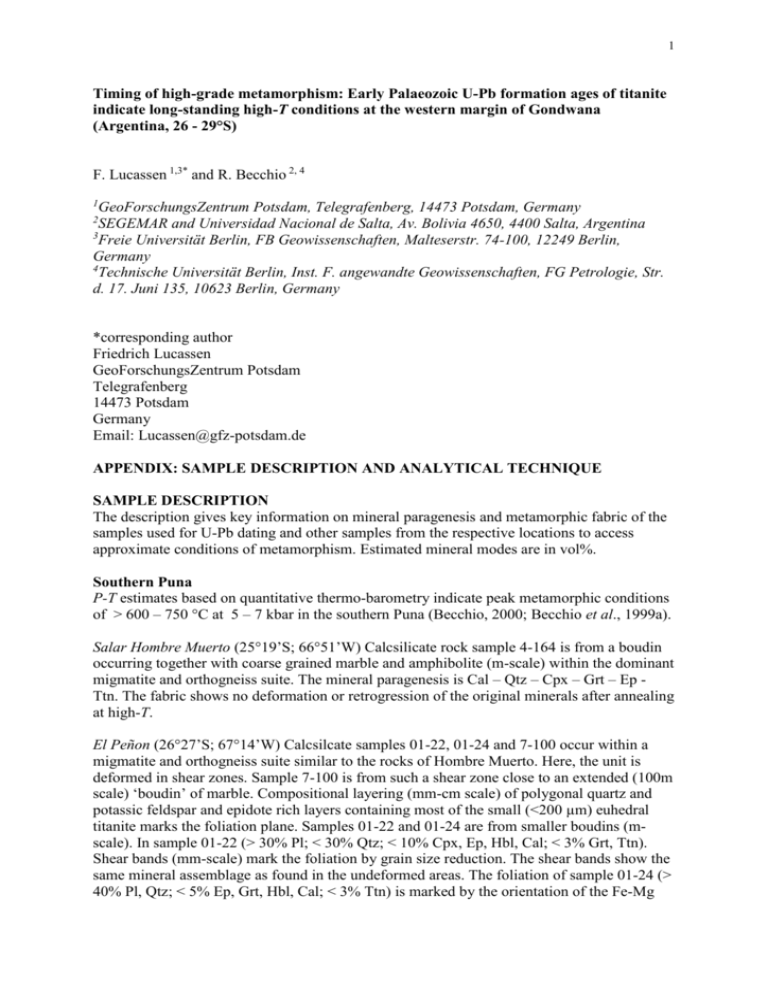
1 Timing of high-grade metamorphism: Early Palaeozoic U-Pb formation ages of titanite indicate long-standing high-T conditions at the western margin of Gondwana (Argentina, 26 - 29°S) F. Lucassen 1,3* and R. Becchio 2, 4 1 GeoForschungsZentrum Potsdam, Telegrafenberg, 14473 Potsdam, Germany SEGEMAR and Universidad Nacional de Salta, Av. Bolivia 4650, 4400 Salta, Argentina 3 Freie Universität Berlin, FB Geowissenschaften, Malteserstr. 74-100, 12249 Berlin, Germany 4 Technische Universität Berlin, Inst. F. angewandte Geowissenschaften, FG Petrologie, Str. d. 17. Juni 135, 10623 Berlin, Germany 2 *corresponding author Friedrich Lucassen GeoForschungsZentrum Potsdam Telegrafenberg 14473 Potsdam Germany Email: Lucassen@gfz-potsdam.de APPENDIX: SAMPLE DESCRIPTION AND ANALYTICAL TECHNIQUE SAMPLE DESCRIPTION The description gives key information on mineral paragenesis and metamorphic fabric of the samples used for U-Pb dating and other samples from the respective locations to access approximate conditions of metamorphism. Estimated mineral modes are in vol%. Southern Puna P-T estimates based on quantitative thermo-barometry indicate peak metamorphic conditions of > 600 – 750 °C at 5 – 7 kbar in the southern Puna (Becchio, 2000; Becchio et al., 1999a). Salar Hombre Muerto (25°19’S; 66°51’W) Calcsilicate rock sample 4-164 is from a boudin occurring together with coarse grained marble and amphibolite (m-scale) within the dominant migmatite and orthogneiss suite. The mineral paragenesis is Cal – Qtz – Cpx – Grt – Ep Ttn. The fabric shows no deformation or retrogression of the original minerals after annealing at high-T. El Peñon (26°27’S; 67°14’W) Calcsilcate samples 01-22, 01-24 and 7-100 occur within a migmatite and orthogneiss suite similar to the rocks of Hombre Muerto. Here, the unit is deformed in shear zones. Sample 7-100 is from such a shear zone close to an extended (100m scale) ‘boudin’ of marble. Compositional layering (mm-cm scale) of polygonal quartz and potassic feldspar and epidote rich layers containing most of the small (<200 µm) euhedral titanite marks the foliation plane. Samples 01-22 and 01-24 are from smaller boudins (mscale). In sample 01-22 (> 30% Pl; < 30% Qtz; < 10% Cpx, Ep, Hbl, Cal; < 3% Grt, Ttn). Shear bands (mm-scale) mark the foliation by grain size reduction. The shear bands show the same mineral assemblage as found in the undeformed areas. The foliation of sample 01-24 (> 40% Pl, Qtz; < 5% Ep, Grt, Hbl, Cal; < 3% Ttn) is marked by the orientation of the Fe-Mg 2 minerals and titanite in the well annealed plagioclase-quartz matrix (Fig. 2a). Retrogression in the samples is restricted to sericitization of plagioclase. Cerro Plegado (25°59’S; 68°19’W) A small monzogranite intruded into a series of granitic – dioritic orthogneisses and amphibolite. Contacts between intrusions and metamorphic rocks show ductile deformation. Sample An3-39 is from an orthogneiss composed of Pl, Kfs, Qtz, Bt, Hbl and Ep. Titanite are relatively large (c. 250-500 µm). The epidote belongs to the peak metamorphic assemblage. Preferred orientation of biotite and hornblende mark the foliation plane. There is only one deformation fabric present in the sample. Cazadero Grande (27°19’S; 68°10’W) Samples 01-35 and 01-43 are impure marble to calcsilicate and occur together with minor amphibolite in boudins (m to 10m-scale) within a unit of deformed migmatite. Locally intercalation (dm-scale) of marble, amphibolite and quartzite is preserved in the migmatic gneiss indicating a sedimentary origin of the protoliths. The fabric of 01-35 is formed by equigranular, polygonal calcite (>90%) with amphibole and epidote as other primary minerals, all without preferred orientation. Large (>250 µm) and small (>>250 µm) euhedral titanite are randomly distributed. Secondary minerals are clay minerals and some quartz. Yellow and clear euhedral titanite in sample 01-43 (>60% Cal; <10% Qtz, Pl, amphibole, Kfs) are randomly distributed in the equigranular fabric. Western Sierras Pampeanas Preliminary P-T estimates based on quantitative thermo-barometry indicate peak metamorphic conditions of > 600 – 700 °C at c. 7 kbar in Sierras Umango and Maz (Fernandes et al., 2002). Sierra Toro Negro (28°18’S; 68°13’W) The unit of migmatite and minor marble, calcsilicate and amphibolite is very similar to the rocks found at Cazadero Grande. Sample 01-54 is a layered (mm to cm-scale) calcsilcate from a boudin (m-scale). The bright layers (Kfs, Pl, Cpx and minor quartz in variable modes) show a well annealed polygonal equigranular fabric similar to the dark layers (Ep, Cpx and Pl, amphibole, Qtz in variable modes). Both layers contain small amounts of calcite and titanite. Sample 01-60 with >70% quartz and minor plagioclase and patchy Cpx-Ep-Grt-Cal aggregates is from the core of a calcsilicate boudin (m-scale). Titanite occurs within the Qtz – Pl matrix and in the aggregates. The minerals show no preferred orientation. The surrounding migmatite are uniform in their mineral paragenesis. The well-developed foliation is marked by the preferred orientation of biotite and variable modes of Bt - Qtz – Fs. Feldspar and quartz form polygonal fabrics. Minor garnet occurs in most samples, Sillimanite and/or potassic feldspar and cordierite is present in some samples whereas white mica is absent. Sierra Espinal (28°56’S; 68°17’W). Migmatite at Espinal indicates slightly lower temperatures than at the other sample locations and muscovite is still stable in the assemblage Pl – Qtz - Bt – Ms - Grt. Minor volume of amphibolite ( >80% Hbl; < 20% Pl, Qtz) is not associated with the calcsilicate and shows a polygonal fabric and no retrogression or deformation after annealing of the fabric. The two different calcsilicate samples are from boudins (10 m-scale). Composition of sample 01-69 is > 40% Ep, < 20% Cpx, Cal, Qtz. The fabric of the coarse-grained rock (grain size > 5 mm) is equigranular without preferred orientation. Garnet and clinopyroxene show a patchy distribution in the well-annealed fabric of coarse-grained sample 01-70 (>60% Cal; <20% Cpx, Grt). Large (> 250 µm) and small (<< 250 µm) euhedral titanite are randomly distributed in both samples. 3 Sierra Umango (29°02’S; 68°46’W) A marble layer (c. 20 - 100m thick, lateral extension some km) occurs within a unit of deformed migmatite (Qtz, Pl, Bt, Ms, Grt). The muscovite may have formed during the deformation of the migmatite. Amphibolite (Hbl - Pl - Qtz- Grt Bt in variable modes) layers (cm - m - scale) are locally intercalated with marble/calcsilicate rocks. The marble contains numerous tectonically eroded clasts (cm - m scale) of the surrounding deformed migmatite (Pl - Qtz – Bt and minor Grt in variable modes) which are entrained in the calcite matrix without reaction textures around or in the clasts. Sample 01-80 (Fig. 2b) is an undeformed marble (> 90% Cal, < 10% isolated grains of Cpx, Pl, Qtz, Ttn) without preferred orientations in the equigranular fabric. Titanite of different size is randomly distributed in the sample. Marble sample 01-89 (Fig. 2c) from the same large outcrop has been deformed in a shear zone. Grain size of calcite is reduced in comparison with sample 01-80 and the calcite - grains show a preferred orientation. Titanite behaves refractory whereas other minerals appear to be rounded. Sierra de Maz. Samples are from two sample sites at the eastern and western slope of the mountain range. At the eastern slope (29°12’S, 68°22’W) deformed migmatite (Qtz, Pl, Bt, Grt in variable modes, some samples contain sillimanite and potassic feldspar) is common. Calcsilicate rock sample 01-125 shows a polygonal fabric of coarse-grained calcite (> 60%) and < 20% clinopyroxene and epidote, < 10 vol% plagioclase, amphibole and sericite after grown after plagioclase. Sample 01-128 (Fig. 2e) is an epidote-rich (>80%) calcsilicate with small layers (mm-scale) containing plagioclase, quartz and amphibole, and pods (mm-scale) of potassic feldspar. Small ‘yellow’ titanite mark the foliation within the polygonal equigranular matrix made up by epidote. This is an example of a fabric where the titanite may have been deformed and recrystallized within a rigid epidote matrix with subsequent annealing of the epidote. Clear titanite in this sample is restricted to amphibole-bearing layers. Sample 01-122 shows euhedral titanite in an epidote – minor pyroxene and garnetmatrix. The titanite grew at the expense of rutile, which is preserved in the cores of some titanite grains (Fig. 2f). At the eastern slope (29°10’S, 69°27’W), garnet - micaschist (> 30% Qtz, > 20% Pl, Ms, Bt, <10% Grt, St) is the common rock type in the medium grade metamorphic rocks. In the western slope (29°27’S, 68°30’W), the deformed migmatite is also the principal rock type. Amphibolite (sample 01-108; >70% Hbl, <20% Pl, Qtz, <1% Ttn, minor Grt), marble and calcsilicate rocks are subordinate to the migmatite. Titanite of layered calcsilicate sample 01-111 (Fig. 2d; Cpx, Grt, Ep, Qtz in variable modes) occurs in a matrix of Cpx, Ep and Grt and marks the foliation by preferred orientation of the euhedral titanite grains. Sample 01-116 consists of epidote (approx. 100%) and amphibole - rich (>70%) domains with epidote and quartz (< 30%). Yellow titanite occurs in the epidote-rich domains clear titanite in the amphibole - rich. ANALYTICAL TECHNIQUE Titanite was pre-concentrated by the use of a magnetic separator and heavy liquids. Euhedral grains free of inclusions were handpicked under the binocular microscope. Different size fractions or optically different types of titanite have been selected, whenever possible. Up to eight fractions (each c. 10 - 40 grains depending on the grain size) of each sample were analysed to evaluate the reproducibility of the U-Pb ages and to check for the influence of accidental inhomogeneity of the sample or analytical bias (Table S1). After cleaning in warm 7n HNO3 for 1h and ultra clean water the grains were weighed into 3 ml SavillexR containers. A mixed 205Pb-235U tracer was added to the samples before dissolution in conc. HF on the hot plate overnight. After transformation of the samples into chloride, U and Pb were separated on 100µl columns by the use standard HCl - HBr - HNO3 chemistry. 4 Pb and U have been measured at c. 1270°C and 1370°C on a Finnigan MAT 262 mass spectrometer from the same single Re-filament using a silica-gel and phosphoric acid emitter. The raw data were processed and ages calculated using the program packages PBDAT (rev. 1.24; Ludwig, 1993) and Isoplot/Ex (rev. 2.49; Ludwig, 2001). Measured isotope ratios were corrected for spike composition, (0.1± 0.05)% for mass fractionation per a.m.u, blank (Pb: 15 pg ±7.5; U: 1 pg ± 0.5), and initial Pb composition from feldspar or calcite (Table S2) or using Pb isotope composition calculated at 500 Ma from crustal-lead evolution (Stacey & Kramers, 1975; samples 4-164, 01-22, 01-24, and 01- 116). The reproduceability of SRM 981 during the period of data aquisition was 206Pb/204Pb = 16.90±0.01 (n=52). Common Pb composition was determined for a selection of samples on feldspar and calcite (Table S2), in order to correct for the common Pb content of the titanite. Feldspar was leached in warm diluted HF, calcite in diluted acetic acid before dissolution in order to remove secondary radiogenic Pb. Pb was separated by standard HCl-HBr chemistry and measured at 1250°C from single Re-filament using a silica gel and phosphoric acid emitter. REFERENCES Ludwig, K. R., 1993. PBDAT - A computer program for processing Pb-U-Th isotope data, Version 1.24. US Geological Survey open-file report 88-542, 33p. Ludwig, K. R., 2001. Isoplot/Ex rev. 2.49 - A geochronological toolkit for Microsoft Exel. Berkeley Geochronology Center Special Publication No 1a, 56p.
